by Russ Lockwood
Designer: Craig Besinque
Publisher: GMT Games
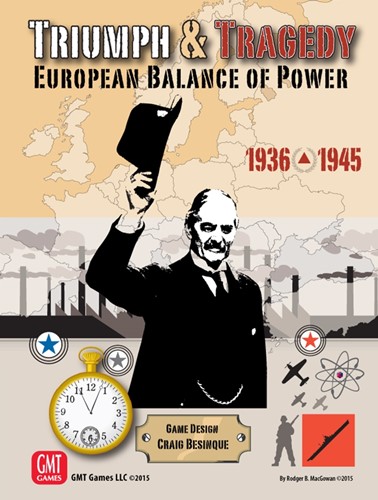
Dan wanted to try his five-player variant of Triumph and Tragedy (T&T), so he set up the game,
e-mailed us all a map, starting units, and card faces, and away the five of us started.
I was the UK. Fred was France. I didn’t know who controlled the other countries (Germany, Italy,
and USSR), but later discovered Sean D. controlled Germany, Ed controlled Italy, and Sean S.
controlled the USSR.
My previous, encapsulated AARs of this game’s events were short of details because the game was ongoing. The following version includes my thoughts at the time of the turns. Then, it’s Umpire Dan’s recap and observations so you get the entire picture, not just my slice of it, plus our
intrepid Il Duce explains Italian efforts.
Fog of War
T&T uses blocks as units and like Stratego and Columbia Games’ block games. The block faces remain hidden unless attacked or attacking. Card play for diplomacy (‘Government Phase’ in T&T lingo) is usually card by card, but Dan divvied up the Phase into a maximum of three sub phases to make it easier for the PBeM umpire. As long as one player plays a card, the next sub phase occurs, but if nobody plays a card, the Government Phase ends. You get an updated map at the end of each sub phase
— that must have kept Dan hopping!
Tech Twist
For this game, instead of needing two matching Technology cards to obtain a particular technology, the Germans, Italians, French, and British only needed one Tech card. It only applied to the country that played it, not their ally.
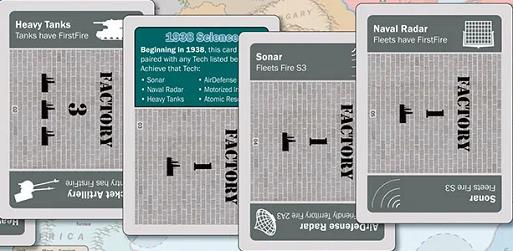
As for the Soviets, they still needed two tech cards unless another country was showing a
technology, in which case, the Soviets only needed one card to ‘match’ and obtain the rival technology. Tech came out a little faster than usual in this variation. The Soviet exception was atomic bombs – two cards needed per level (four in the game, so eight cards total).
Production Mechanic
T&T uses the ‘one production point buys one of anything’ mechanic. So, when the West has seven
production points (split four for UK and three for France), they can buy seven somethings – seven
diplomacy/movement cards, seven factory/technology cards, seven strength points of any type of
ground, air, and naval unit, or some combo of these. The only question is: Whatcha gonna buy?
I always felt that I was robbing Peter and Pierre to pay Paul and Francois. I always needed more of each to keep up with the Hermanns, Luigis, and the Ivans. So, if I’m behind on industry, and then if I boost that, diplomacy and military preparedness suffers. But if I boost one of those, then the other two suffer. It is a brilliant mechanic that causes a delicious player dilemma. It’s also what makes the game so replayable.
Turn 1936
All five players boosted their industry and the Germans, with their initial double hand size of
diplomatic cards (14 to offset the eight West and six USSR cards), proceed to run wild in Central
and Eastern Europe. The Soviets spoke smoothly to Greece and Bulgaria. Us Brits sweet-talked
Poland.

Oddly enough, the Italians pursued an Anschluss with Austria, something we Brits opposed. The
Italians did sweet talk the Danes while the French buttered up Spain. The Soviets invaded Persia, but failed to conquer it in one turn. Unlike most games, ground battles get one round of combat (naval battles get multiple rounds).
The UK has four units in India, two of them immovable fortresses — although if I was cleverer, and Dan did warn me, I would have made them something mobile, for while you can always build a fortress in any area, I can only build non-fortresses in the UK. Here, I admit a pre-game falter with the rules, for I saw the sub-capital Delhi in India and thought I could build units there. Not so. Of note: The Germans received LST and Mechanized Infantry technologies and the Italians received LST technology. I told you tech came out mighty quick with the one-card play!
The UK looked upon Axis LSTs with concern, just as the USSR looked on Axis Mechanized Infantry with concern. As a game mechanic, pairing the tech with the factory on one card and only being able to pick one really creates dilemmas. For builds, most UK units remained at initial cadres, although the Brits built a fortress at Malta and an infantry cadre in London.
Turn 1937
More factory builds all around and more diplomatic plays. The Germans tried for the US but were
evicted, just like the Italians were tossed out of Latin America. The British tried mightily in
Poland, but the Axis would have none of it. A variety of ploys and snubs left the map with the
Germans still strong in Central Europe, the Soviets in Southern Europe, and a smattering of other
diplomatic coups elsewhere.
Of note, the Italians obtained their long-desired anschluss with Austria! That’s the luck of the
diplomatic card draw, folks. The Soviets got Mechanized Infantry technology via a tech card. Tech fast, anyone?
For builds, the Germans and Italians started to boost unit strengths or build new cadres, four
apiece, while the French built a new cadre in Lorraine and the UK built armor and infantry cadres
in London.
The Soviets finally captured Persia and the UK and USSR quickly came to a non-aggression agreement on that side of the world.
Digression on Diplomacy
The British traded diplomatic messages to Italy, Germany, France, and the USSR trying to get an
idea of what to expect. All messages were sent anonymously through Umpire Dan. When I received a message, I did not know the e-mail address — only who sent the message. Presumably, when I sent a message, it was always signed Prime Minister Chamberlain.
France, being an ally, was tight, often acting on UK suggestions or suggesting alternatives. I’m
not quite sure how involved Fred was in the negotiations, for his written responses were quite
terse. As it turned out, early on it was more umpire interpretation than French ally.
From Italy, we got a half-understanding not to screw with the UK in the Med if we didn’t screw with the Italians. The Italians were concentrated and next to their build center, so we agreed, although that didn’t stop me from ramping up fortresses at Malta and Gibraltar and sending another unit or two into the Mediterranean.
For Germany, we tried a little diplomacy, offering it a free hand in Poland and Central Europe in
exchange for leaving Northern Europe (Sweden and Norway) to us. Hitler dithered too long before sending a long political message, and promised nothing except anti-Communism. So much for that idea.
I stuck an influence in Poland. Germany removed it. I apologized for the wasted maneuver, but noted Hitler had not responded quickly enough. Literally, there’s not much I can do — France had all the good diplomacy cards.
As for the Soviets, the West had to play along, in part because of the German-Italian head start.
We quickly sorted out spheres of influence to try and keep Germany from controlling too many
countries.
Turn 1938
I increased fortress levels at Malta and Gibraltar while UK, France, Germany, and the USSR
increased factories again — Germany by another two. At this point, the Axis can build 17, the West
12, and the USSR 11. Thus, the Soviets and West must coordinate to tamp down the Axis. Otherwise, if the Germans and Italians can concentrate on one, the odds are very much in the Axis favor.
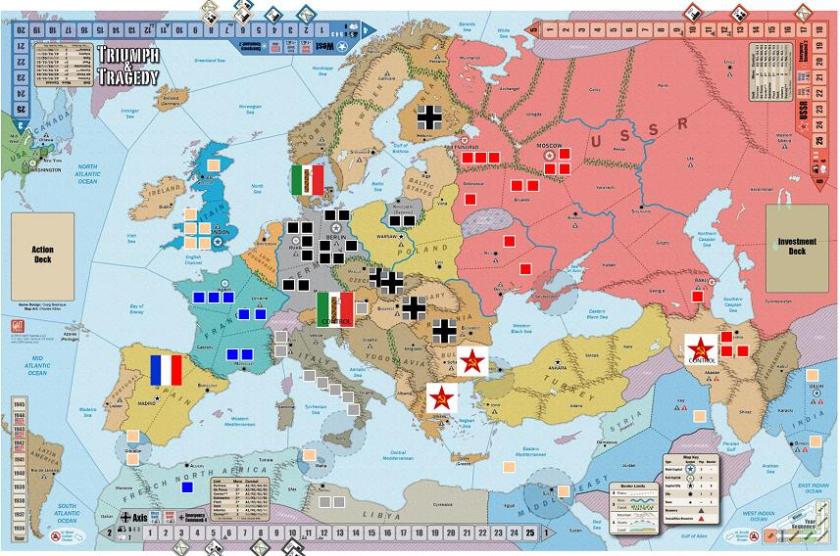
Diplomacy wise, Germany gathered Czechoslovakia under its full control while France did a paper blitz on Yugoslavia to control that. The Soviets whacked a few Axis initiatives in Hungary and Denmark. Germany had built up a nice influence in Turkey. Everything else was up for
grabs with single plays here and there. I am surprised that British influence in Poland remained.
So far, Western-Soviet cooperation held.
Now to see whether the Axis will be spooked into attacking any of the countries with a single
influence.
Conquest of Poland and Hungary
The Germans invaded Poland and Hungary in the Summer of 1938, capturing both with minimal losses. This proved a bit of a surprise to me, as I expected the Germans to move north, not east. I guess they showed the Soviets how it was done, and I guess the Soviets were now nervous.
The UK certainly was, for the Italians transferred two units next door to Egypt, upgraded a unit in
Rome, and built three new cadres in Taranto. Whether that’s a bluff or not to focus attention in
the Med — who can say on the Allied side? But it did cause me to recall the unit from Iraq to
Egypt, transfer an infantry from the UK, and upgrade the units in the Med in 1939.
Turn 1939
Diplomacy wise, it’s more cat and mouse around Europe. The northern countries saw a shuffle that changed nothing, although Finland and Romania went back to neutral. Across the pond, Latin America lost its Allied influence, but France tightened its grip on the USA. I was surprised to see that Turkey did not turn into a German ally.
Spring was quiet, but Summer turned out to be a wild ride for the UK. I invaded Norway, figuring I
better do it before Germany did. I also continued diplomatic messaging with Germany, Italy, and the USSR trying to assure all of them that the weak, timid UK is standing on promises made in previous messages. For example, the USSR said they were considering invading Finland, which had a German influence on it. I suggested that if I could remove that influence, they didn’t have to invade. I indeed played a diplomatic card on Finland, explaining to Germany that I was doing him a favor by avoiding a Soviet Finland (the USSR already had an influence in Sweden), and noting that the Germans canceled my influence in Norway, which I completely understood given the Finland diplomacy.
I told the Italians that I was asking the French to de-escalate tensions with a move of the Croatia
unit to Syria — this is actually a move to thwart any Turkish attack towards Iraq and Persia (which I told the USSR I was doing for the good of us both).
The danger here was that Germany might declare war on the West while I’m off in Norway. I stuck the biggest Royal Navy unit I had in the North Sea to bar the way, but there’s little I can do against a concentrated effort. I would have preferred to use the unit to help the invasion, but it is the best I can do to protect London. I am gambling that Germany will not attack, figuring that would leave him open to a Soviet attack. As a hedge, I also moved the infantry unit from Gibraltar back to London. In the Fall, I’ll play another movement card to reshuffle units.
For 1940, it’ll be more armed forces increases although a couple diplomatic cards may be necessary to actually move units. We’ll see. This uncertainty is what makes this a great game.
Of course, luck always plays a part — despite the attacks by two air units and two fleet units this turn, they could all miss and the Norwegians hit. Next turn, all my units could fail to hit and the Norwegians hit…and so on until my entire invasion force is smashed. Hey, in the PBeM Axis & Allies game, British luck is almost universally bad, so I figure that in T&T game, British luck will be almost universally good! Hey, it’s a theory. We’ll see.
An inauspicious start: I mixed up the T&T and A&A rules for amphibious invasion, so the armor unit would have to remain home. I moved it to Scotland just in case I needed it next turn. Now the margin of error (luck) dropped a notch.

UK Invasion of Norway
As expected, the Norwegian fortress took out one of my two infantry strength points, with the
survivor unable to fire due to the way the rules work for amphibious assaults. However, while the RAF and French AF planes did nothing, the Royal Navy pounded the fortress into ruins and the UK planted its flag over Oslo. The Nazi agitator Quisling was rounded up and tossed into prison.
As for us victors, I’m playing another movement card to re-align my troops (such as they are) back to the UK. Now, what will the Germans do?
Turn 1940
While the UK and France shuffled units about to prevent any Axis moves against the West, the Axis got busy. The Axis attacked Turkey, Denmark, and BeNeLux in one notable Spring turn. Denmark and BeNeLux fell.
In Turkey, the Axis played a long game.
And then, just when you didn’t think it could get any worse, The Axis invaded Sweden, too. Turkey
was conquered, but Sweden held on — not that the Allies could do anything about it. There’s no
such thing as lend lease.
The Soviets readjusted their defenses.
Turn 1941
The Axis in Turkey moved westward and invaded Bulgaria and Greece. Both of these, plus Sweden, fell in the Spring. UK and USSR adjusted defenses.
In the Fall, the Axis struck again, this time invading Finland, although the doughty Finns held
out.

Diplomatic efforts to sway Spain and Portugal evened out and at the end of the year, no one had any influence in either. South America was almost in the Western camp, needing one more diplomatic push to become allies. Then again, Spain was almost in the French camp before Soviet aggression wore down Franco into neutrality. So much for Western-Soviet cooperation. This would come back to haunt Stalin…
Tech advances were scattered on all three sides. The Axis held a slight advantage in industry, but
collectively, the West and USSR totaled more than the Axis.
Turn 1942
At the start of the 1942 turn, Germany controlled all of central Europe except for Yugoslavia
(French) and all of Scandinavia except Norway (British).
The USA was solidly in the Western camp and this turn began the US build-up. It was very modest at only a total of four strength points across four units, but it was a start.
The Axis possessed the central position. Do they wait a year and then strike in 1943? Do they judge the West or USSR weak enough to take in 1942? Can the West or USSR afford to wait as the Germans pile up the points?
For the Spring, the USSR and Axis played cards, with the USSR going first — hesitation or attack?
Will the Axis head east, west, or stay put?
Spring: West Passes
The French and British debated whether to play a card or not, but the defensive lines we set up
looked good enough to withstand any Axis or Soviet assault. Oh, we’d lose an area or two, but any attack would also unleash the US forces — our strategic reserve. Looking at the map, we decided to hold off moving anything, content with a flexible defense.
Spring: War of the Three Amigos
The USSR saw the peril and struck first, declaring war on the Germans and Italians. Stalin played
an early card: B4, edging out the Axis’ E5. In T&T, moves and combat occur in alphabetical order,
so the Soviets went first, but with only four units.
A Soviet blitzkrieg rolled through Finland and Sweden, capturing both countries. In the case of
Sweden, the German garrison consisted of a single strength point of aircraft — not the type of
unit to hold Stockholm in the face of a pair of Soviet motorized infantry units. The Luftwaffe
retreated to Denmark.
Spring: Axis Response
Two German motorized infantry units and one Italian motorized infantry unit headed from Ankara (Turkey) to Tabriz (Persia) to attack the Soviet unit there. Meanwhile, a German infantry unit invaded Georgia (USSR). The fifth unit transferred from BeNeLux to Warsaw (Poland). As per the fog of war in the game, we don’t know what type of unit this was or its strength.
In Georgia, the two enemies traded hits, but both remained in the area. In Tabriz, the multitude of Axis motorized infantry overwhelmed the solitary defending tank unit without loss.
End of Spring
With Axis and USSR engaged in a war, we did foresee a possible attack into India, which could put a hurt on the Western economy. The West made plans to shuffle a couple units back to Karachi (India). As for the rest, we made plans to invade Spain with a large combined force. But first, we had to position troops, fleets, and air within striking range, including staging infantry to Malta.
Summer 1942
The USSR, Axis, and West played cards for the Summer – the USSR with an M- 10 going first, the Axis with a V-8 going second, and the West with a W-7 going last. By being last, we Western Allies can maintain our defense through the Summer turn, just in case the Soviets or Axis tried a surprise move.
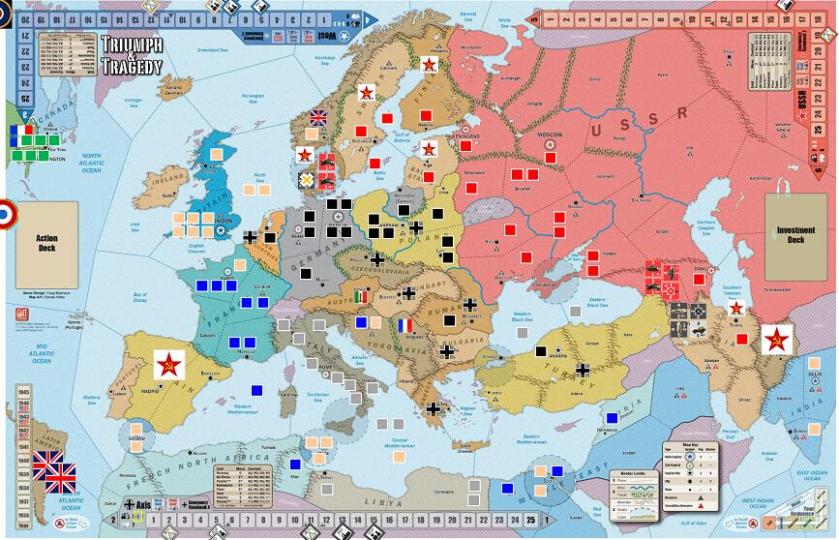
Summer: USSR Reshuffles
The two motorized infantry units parked in Sweden attacked and invaded Denmark, making quick workof the Luftwaffe unit and capturing the area without loss. Another group of units joined the Battle for Georgia, with two tank units pummeling the defending
German infantry, which retreated back to Tabriz.
The rest of the Summer was spent rearranging units for a defense.
Summer: Axis
The West wondered if the Axis would open a two-front war. Although it would seem a bit
self-destructive when Soviet units were banging on the back door in Denmark, you never know. The Axis played it smart and pressed the offensive along the Persian-Soviet border, sending ‘Army Group South’ troops to attack Baku (USSR) and Tehran (Persia).
Tehran fell to the Italians, eliminating the defending Soviet infantry without loss. Persia became
another Axis country. The Axis appreciated the Persian resources that replaced the resources lost
in Finland, Sweden, and Denmark.
At Baku, the battle raged long with losses on both sides, but was ultimately a stalemate.
Meanwhile, back on the Eastern European border, Germany’s ‘Army Group Center’ attacked the areas Kiev (USSR) and Odessa (USSR). Odessa fell to the Germans quickly, but Kiev held out, as much due to German ill luck as anything else. The Axis pulled a unit back from Poland to the Ruhr and sent another unit to Kars (Turkey) to defend the Turkish-Soviet border.
Summer: West
We sent a couple of units to defend India, just in case the Germans have any ideas of opening up a second front with a resource grab. We kept the London and Paris defenses strong — no sense bulking up the periphery if we lose the homelands. The Navy and the potential for no supply by any invasion force is a powerful deterrent. The rest of our shuffling tried to maintain a balance between potential offense and defense of the Atlantic and Mediterranean fronts.
The Germans and Soviets were doing a fine job of bashing each other, leading to the question of when the West will intervene. The West, militarily, is the weakest of the three powers, but if
enough Axis and Soviets units pound each other into oblivion, we’ll slowly gather forces enough to attack. In the meantime, we have to keep close to Axis industry totals.
Fall: Axis and USSR
To my surprise, both the Axis and USSR both passed. Hey! Is this any way to run a war?
Fall: West
The staging complete, the UK and French invaded Spain, driving for the all- important capital of
Madrid. We were a little thin on the ground, only two armies, but we had four fleets and two air
wings in support. We needed every strength point we could gather!
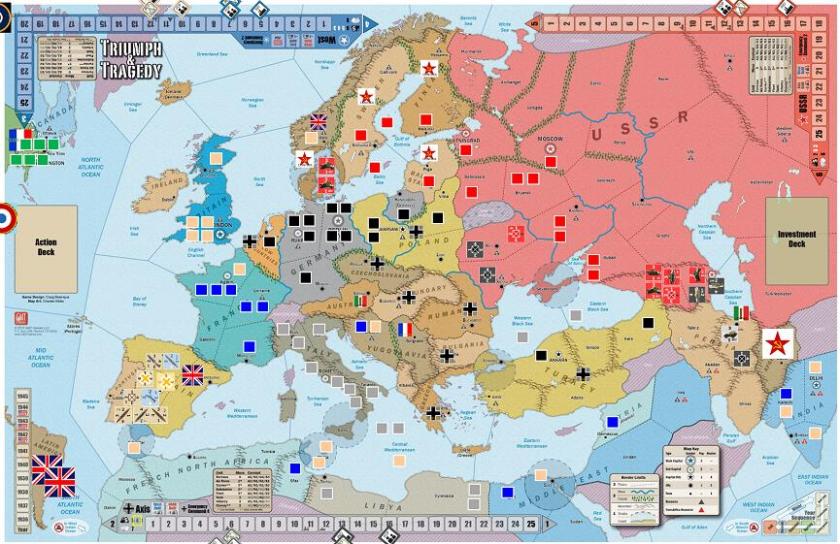
The Spanish fortress, which hits two-thirds of the time, put three hits on three rolls into our poor bloody infantry, leaving but one understrength army left. That’s the way the Spanish dice fell.
Our supporting fire (1 in 6 chance of a hit, with 14 dice tossed) notched a slightly higher than
average 3 hits — enough to demolish the fortress and allow the West to capture the capital, and
with it, Spain. Sadly, the loss of that infantry meant that for next year, instead of a pair of 2
strength point infantry units in the Med, I would only have one unit, necessitating at least two
turns of movement to get a new unit from the UK to the Med.
The reason to attack Spain was to ensure that it did not fall into Soviet hands, for the Soviets
had stuck an influence in the country. Indeed, the USSR had been the West’s bane in Spain that fell mainly on the plain of diplomacy. The French had two influences at one point, but the Soviets not only eliminated them, it added its own. Well, no more.
Soviet Winter Offensive
In T&T, the Soviets and only the Soviets can play a card (any season) and performed winter movement and combat. They did just that and formulated a counterattack that retook Kiev, with the German infantry unit retreating to Odessa, and, chased the Germans away from Baku, one German unit retreating back into Persia while the other hopped back on the ships and landing craft in the Caspian Sea!
Turn 1943: Year of Decision
The year 1943 in our long-running Play by E-Mail game of Triumph & Tragedy started out so equal, it looked like anyone’s game. The year didn’t end that way.
After the Soviets kicked the Axis out of most of Persia, laid siege to Tehran, and advanced into
Turkey, the Axis responded with moving the Italian strategic reserve from North Africa to Turkey.
Meanwhile, in the central sector, the Axis beefed up its units, attacked, and took Kharkov — the
Soviet forward defenses had been breached. Simultaneously, the Soviets lost their defensive line in Turkey, opening up the way to Baku.
The key here was that, via technology, the Axis infantry received a first fire bonus, allowing them
to fire at Soviet infantry (and remove any Soviet losses) before the Soviets fired at them. The end
result was a lack of Soviet firepower and the collapse of the Soviet line. Apparently, with all the tech cards, the USSR didn’t receive, or ignored use of, the ‘Improved Artillery’ card that allows the infantry to fire first. The French had the tech early, so the Soviets could have used one card to match it, but apparently didn’t. It was to prove a fatal technology gap.
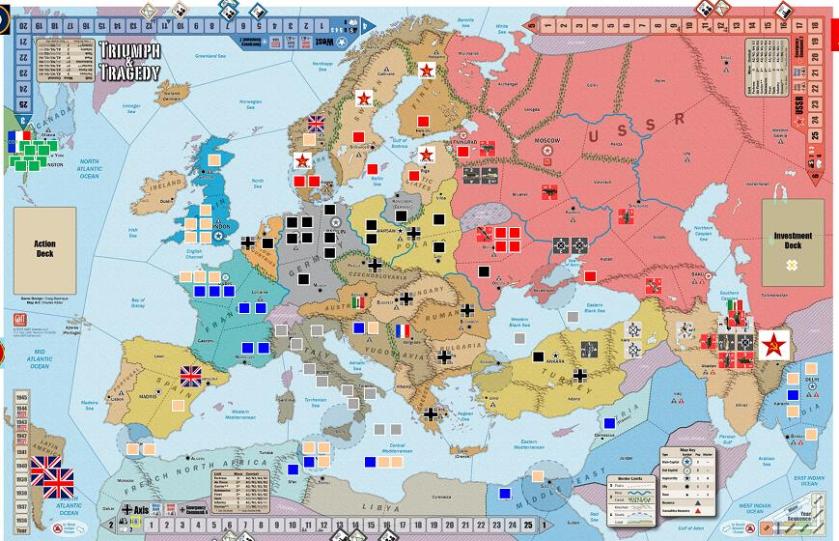
.The West
The West proved blissfully unaware of this state of affairs until the Summer. The West was rapidly redeploying forces for either a Fall 1943 attack or a Spring 1944 attack — depending on the situation of the Axis- Soviet war. In any case, the West was deficient in forces compared to the Axis.
Nonetheless, the French saw the danger of the broken Soviet line at the end of the Summer season. The British didn’t mind, as the British, so typical, just didn’t understand the nuance of the victory rules. The British knew military victory occurred when two capitals (Moscow, Berlin, or
London) or sub-capitals (Paris, Rome, Baku, Delhi) were captured, but thought the capture had to be at the end of a season. Thus, if a side grabbed two victory areas early in a season, the other side had a chance to recapture.
Not so! The victory occurs at the exact moment of the capture of two capital/sub-capitals.
The Soviets had goofed in a previous combat when they retreated a unit out of the way to Stalingrad instead of Voronezh, leaving the road to Moscow open. When the Axis went first in the beginning of the Fall seasonal turn, they marched unopposed into Moscow and Baku and won the game.
What!? Whaddaya mean it’s over? The war was going so well. The West avoided a suicidal early war. We were on the cusp of military equality with the Axis. The Germans and Soviets were in a death grip. The West was about to drop the hammer of democracy on the Axis…
The declaration of Axis victory came as a surprise to the West, or at least to me as the British. Even a Soviet counterattack might prove useless, but the game was over. Certainly, given the hole
in the Soviet line, the West would have launched a Fall attack on the Axis. Indeed, the plans for a
Fall 1943 offensive by the West were quite advanced and plotted out on the assumption that the
Axis-Soviet war would be in full vigor. Not that there would be much to accomplish except knock the Axis production down for a turn, but it might have been enough to pull the 1944 US forces into Europe for eventual victory. Alas, it was not to be.
Great Game
Dan ran an excellent T&T campaign game with nice fog of war aspects. I can’t tell you how many
entertaining hours I devoted to each turn, but certainly ran through a considerable number of
if-then options in my head. When a game gets me to thinking and speculating and thinking some more, that’s a good game.
As the British, I was amazed at how many big strength-point units the Axis had versus us in the
West — but upon further analysis, the big difference was the mobility of Axis units. Since they can build any unit in Italy, they have the central position. The British can only build fortresses outside the UK. Thus, the Italians had created a ‘strategic reserve’ of a pair of 3 SP motorized units that moved from North Africa to Turkey for the final push to Baku. The British had
a 3 SP fort in Suez, a 3 SP fort in Malta, and a 3 SP fort in Gibraltar as necessary, if immobile,
units to hold open the Mediterranean trade route. The French had a 3 SP fort in Croatia. The
Italians had a 3 SP fleet in the Central Med and a 3 SP air unit in Rome. The British had a 3 SP
fleet in the Central Med along with a 2 SP French Fleet and 1 SP British submarine. Points-wise,
about a draw, but mobility wise, no contest.
The Western strategy to avoid being dragged into a war before its military can be built up worked, although if the Axis is intent upon an attack, it has the military edge. The Med is a key locale, for half the West’s resources shuttle through it. Losing one of the key spots of
Malta-Gibraltar-Suez or even one sea area cuts off a quarter of Western resources (the other
quarter go around the southern tip of Africa).
Still, although the French noted the West was ‘too timid’ in 1943, it is hard to see how much the
West could influence 1942 other than to start a war for which we were somewhat ill prepared…although in retrospect, doing anything at least had a chance of easing the pressure on
the Soviets. Up until the Spring 1943 Axis attack, it seemed a nice, even game of attrition, just
what the West needed to catch up to the might of the Axis. But whaddaya know? Operation Citadel worked! Well played!
And now for the umpire’s view of the game…[to be continued in another post}
About the Author
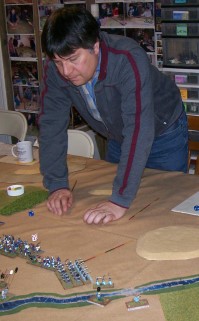
Russ Lockwood has been bouncing around the wargaming world for the last 25 years in one capacity or another. Most know him as creator and CEO of MagWeb.com (on-line archive of 162 military history and related magazines from Coalition Web, Inc. from 1996-2009). He appeared on camera on The History Channel (Modern Marvels), ABC, NBC, Fox, and various cable TV shows. MagWeb was also covered by the NY Times, USA Today, and other newspapers, a variety of trade and consumer magazines, and a multitude of on-line sites. He’s given lectures at various HMGS conventions, Origins War College, and various professional meetings and seminars. Although MagWeb closed in 2009, those white MagWeb rulers still appear on wargaming tabletops across the country.
On the prior professional front, Lockwood was Editorial Director of AT&T’s web division, Senior Editor at Personal Computing Magazine, Assistant Editor at Creative Computing Magazine, Telecommunications Editor for A+ Magazine (Apple), tech writer at AT&T, Staff Writer (Financial) NY Times Information Service, and freelancer for PC Sources, Windows Sources, PC, MacUser, Byte, Restaurant Business, Hotel Business, Computer Buyer’s Guide and Handbook, and other magazines. He also hosted a radio show, ComputerWise, for five years, and was an on-line editor for ZiffNet on Compuserve and Ziffnet on Prodigy.
He is currently a freelance editor and writer covering financial and defense news, with a concentration on the retail industry. If you are really interested, go to Linked In, where he maintains a profile.
On the miniatures front, you may have seen his byline in various hobby publications in the 1990s and 2000s. Lockwood is also the author of: Snappy Nappy: Simple, Subtle & Ultrafast Miniature Rules for the Napoleonic Era, and, Hyperspace Hack: Ultrafast Spaceship Fleet Battles with Miniatures (both published in 2009 and available from http://www.onmilitarymatters.com and http://www.caliverbooks.com). Lockwood is also the editor of the Secrets of Wargame Design series, releasing the fifth volume in 2015.

Sounds like a fascinating game. Will definately play it when I get the chance.
Cheers,
Pete.